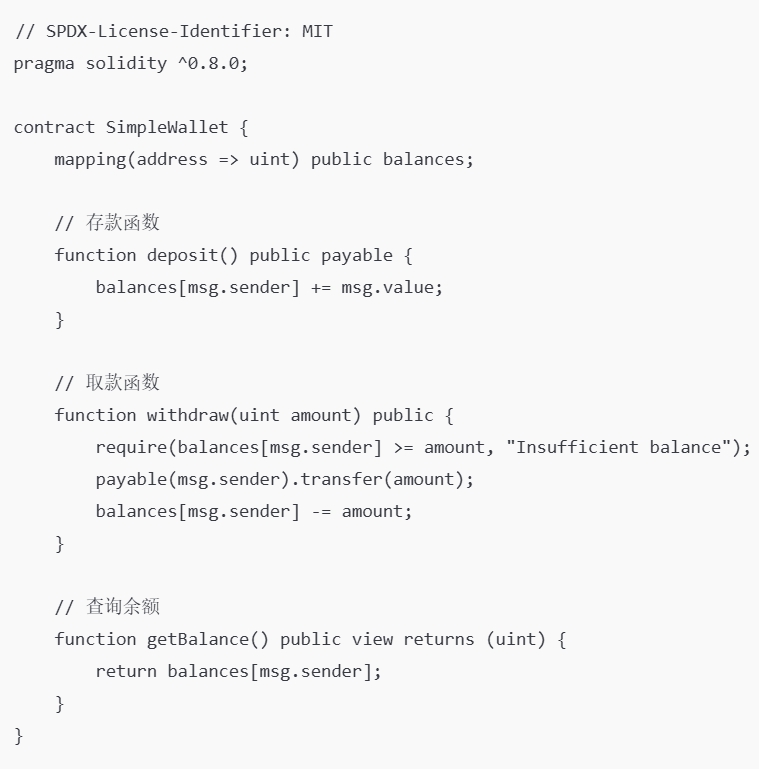Smart Contract Writing and Debugging in DApp Development
- latest articles
- 1.DApp Development & Customization: Merging Diverse Market Needs with User Experience 2.Analysis of the Core Technical System in DApp Project Development 3.How to achieve cross-chain interoperability in Web3 projects? 4.How does the tokenization of points reconstruct the e-commerce ecosystem? 5.How to Set and Track Data Metrics for a Points Mall? 6.What is DApp Development? Core Concepts and Technical Analysis 7.Inventory of commonly used Web3 development tools and usage tips 8.Development of a Distribution System Integrated with Social E-commerce 9.Six Key Steps for Businesses to Build a Points Mall System 10.What is DApp Development? A Comprehensive Guide from Concept to Implementation
- Popular Articles
- 1.Future Trends and Technology Predictions for APP Development in 2025 2.Analysis of the DeFi Ecosystem: How Developers Can Participate in Decentralized Finance Innovation 3.From Zero to One: How PI Mall Revolutionizes the Traditional E-commerce Model 4.DAPP Development | Best Practices for Professional Customization and Rapid Launch 5.Recommended by the Web3 developer community: the most noteworthy forums and resources 6.From Cloud Computing to Computing Power Leasing: Building a Flexible and Scalable Computing Resource Platform 7.How to Develop a Successful Douyin Mini Program: Technical Architecture and Best Practices 8.Shared Bike System APP: The Convenient Choice in the Era of Smart Travel 9.How to Create a Successful Dating App: From Needs Analysis to User Experience Design 10.From Design to Development: The Complete Process of Bringing an APP Idea to Life
With the development of blockchain technology, decentralized applications (DApps) have become the core component of many innovative projects. DApps not only provide higher transparency and security but also eliminate trust issues associated with intermediaries in traditional applications. In the development process of DApps, smart contracts play a crucial role as the core logic component, responsible for defining business rules and operational workflows. However, writing and debugging smart contracts is not a simple task and requires developers to possess strong technical skills and sharp thinking. This article will explore the process of writing and debugging smart contracts in DApp development, including common development tools, debugging techniques, and how to ensure the security of smart contracts.
I. Overview of Smart Contracts
1.1 What is a Smart Contract?
A smart contract is a computer program that automatically executes, manages, or verifies contract terms. It is built on a blockchain network and leverages blockchain technology to ensure the immutability and transparency of the contract. The core function of a smart contract is to automatically execute predefined contract terms without relying on intermediaries, reducing execution costs and improving transaction efficiency.
The programming languages for smart contracts mainly include Solidity and Vyper, with Solidity being the most widely used language, especially on the Ethereum platform.
1.2 Characteristics of Smart Contracts
Smart contracts have the following notable characteristics:
Automated Execution: Once the contract conditions are met, the contract executes automatically without human intervention.
Decentralization: Smart contracts execute on the blockchain, eliminating the role of intermediaries in traditional systems.
Transparency: Smart contracts are publicly transparent, and anyone can view their code and execution records.
Immutability: Once deployed, smart contracts cannot be modified or deleted, ensuring the reliability of contract execution.
II. Writing Smart Contracts in DApp Development
2.1 Choosing Programming Languages and Development Environments
In the DApp development process, the first step in writing smart contracts is selecting the appropriate programming language and development environment. The most common language for writing smart contracts is Solidity, which is based on the Ethereum Virtual Machine (EVM) and has a syntax similar to JavaScript. Developers can use Solidity to implement the logic and functionality of smart contracts.
Additionally, there are tools and frameworks that help developers quickly write and deploy smart contracts, such as:
Remix IDE: A browser-based Solidity development environment that allows writing, compiling, and deploying smart contracts directly in the browser.
Truffle Suite: Truffle is a very popular Ethereum development framework that provides a complete set of tools for compiling, testing, deploying, and debugging smart contracts.
Hardhat: A development framework for building Ethereum DApps, offering rich plugin support, testing tools, and debugging features.
2.2 Basic Process of Writing Smart Contracts
Writing smart contracts typically involves the following steps:
Defining Contract Structure: In Solidity, the structure of a contract includes state variables, constructors, functions, events, etc. State variables are used to store persistent data of the contract, functions define the operational logic, and events are used for logging.
Designing Contract Logic: Based on the requirements of the DApp, design the business logic of the contract. For example, in decentralized finance (DeFi) applications, it may be necessary to design smart contracts for lending, trading, and liquidation.
Implementing Access Control: Smart contracts often need to implement access control mechanisms to ensure that only specific users or contracts can perform certain operations. For example, using
requirestatements to restrict the identity of function callers.Contract Optimization: The execution of smart contracts incurs costs, especially on public chains like Ethereum, where transaction fees (Gas fees) are calculated based on the complexity of the contract. Therefore, when writing contracts, minimize unnecessary computations and storage operations to optimize execution efficiency.
III. Debugging and Testing Smart Contracts
3.1 Challenges in Debugging
Debugging smart contracts is more complex compared to traditional application development because:
Immutability: Once a smart contract is deployed on the blockchain, it cannot be modified, requiring that the code must be free of vulnerabilities before deployment.
Gas Fee Issues: Each contract call requires paying Gas fees, so frequent debugging and testing can lead to high costs.
Differences Between On-Chain and Off-Chain Environments: The execution environment of smart contracts is the blockchain, and differences between the local debugging environment and the on-chain environment can lead to unexpected issues.
3.2 Common Debugging Tools
To simplify the debugging process of smart contracts, developers can use specialized debugging tools and frameworks, such as:
Solidity Debugger: Truffle provides the Solidity Debugger tool, which allows local debugging of Solidity contracts, tracking each step of execution, and viewing variable changes.
Hardhat Network: Hardhat provides a built-in local blockchain network for rapid testing and debugging of smart contracts. Developers can simulate the blockchain environment locally to quickly deploy and debug contracts.
Ganache: Ganache is part of the Truffle Suite and is a personal blockchain for rapid testing and debugging of smart contracts. Developers can use Ganache to create multiple virtual accounts, simulate transactions, and observe contract execution.
3.3 Unit Testing and Integration Testing
Writing unit tests and integration tests is an important step to ensure the correctness of smart contract code. Developers can use the following tools to write tests:
Mocha & Chai: These are commonly used testing frameworks in Node.js. Developers can use Mocha to write test cases and Chai for assertions. Both Truffle and Hardhat support the Mocha testing framework.
Solidity Unit Testing: Simple test contracts can be written directly in Solidity to verify function execution and expected outputs.
IV. Security of Smart Contracts
In smart contract development, security is a very important consideration. Once a smart contract is deployed on the blockchain, it cannot be modified, so the security and stability of the code must be ensured. Common security vulnerabilities include:
Reentrancy Attacks: Attackers repeatedly call the contract's callback function to steal funds from the contract.
Integer Overflow/Underflow: Failure to properly handle numerical boundaries during mathematical operations, leading to incorrect values.
Time Dependency Attacks: Certain operations in the contract depend on block time, which attackers may exploit for manipulation.
To mitigate these security vulnerabilities, developers can use the following strategies:
Using Security Libraries: For example, OpenZeppelin provides audited contract libraries that help developers avoid common security issues.
Security Audits: Conduct professional smart contract audits before release to ensure the contract is free of vulnerabilities.
Reentrancy Protection: Use the
checks-effects-interactionspattern orreentrancyGuardto prevent reentrancy attacks.
V. Summary
Smart contracts are the core component of DApp development. Writing and debugging smart contracts involve language selection, development tools, debugging techniques, and security issues. By using appropriate tools and frameworks, developers can effectively write, debug, and test smart contracts to ensure the functionality and security of DApps. As blockchain technology continues to evolve, the application scenarios of smart contracts are becoming increasingly widespread, and the requirements for developers are also increasing. Therefore, continuously improving the skills of writing and debugging smart contracts is an essential task for every blockchain developer.
-

DApp Development & Customization: Merging Diverse Market Needs with User Experience
As blockchain technology matures and becomes more widespread, decentralized appl···
-

Analysis of the Core Technical System in DApp Project Development
With the rapid development of blockchain technology, decentralized applications ···
-

What is DApp Development? Core Concepts and Technical Analysis
With the rapid development of blockchain technology, decentralized applications ···

 Blockchain
Blockchain












